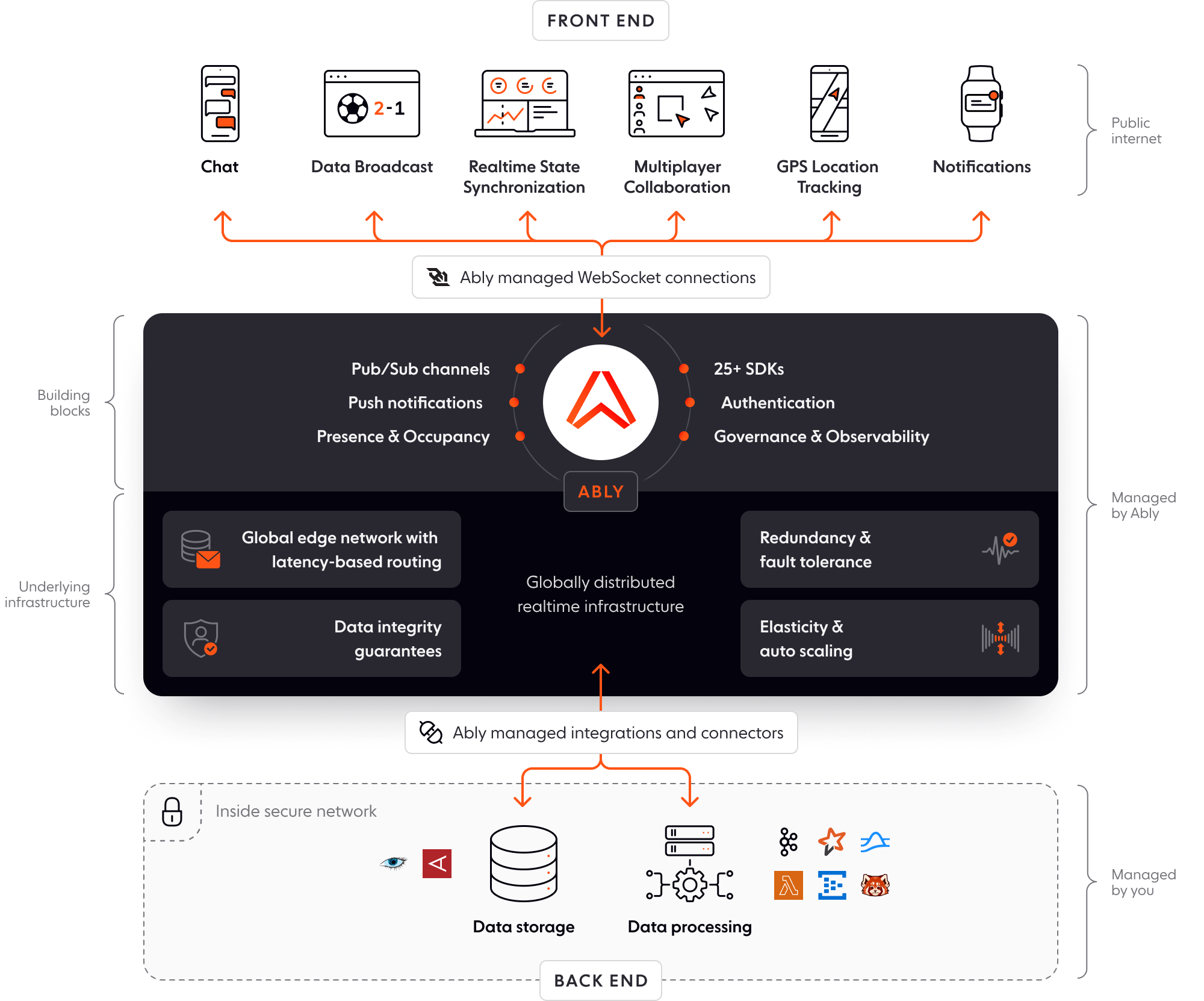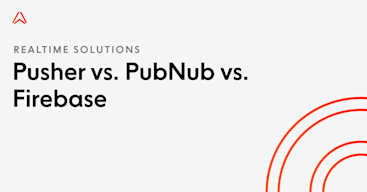- Topics
- /
- Realtime technologies
- /
- SignalR vs. Firebase: Learn about their differences, similarities, and use cases
SignalR vs. Firebase: Learn about their differences, similarities, and use cases
SignalR and Firebase are two of the most popular solutions available to developers looking to add realtime features to their web and mobile apps. But what are the differences and similarities between SignalR and Firebase? What are their advantages and disadvantages? What kind of realtime use cases can you address with these two solutions? When is it best to use SignalR, and when is Firebase a better choice? This article aims to answer all these questions.
SignalR overview
SignalR is a technology that enables you to add realtime functionality to web apps. SignalR comes in several different flavors - it’s available as an open-source library for ASP. NET developers (ASP .NET Core SignalR), but also as a fully managed service (Azure SignalR Service).
SignalR uses WebSocket as the main underlying transport, while providing additional features, such as:
Automatic reconnections.
Alternative transports (long polling and Server-Sent Events).
The ability to send messages to all connected clients simultaneously, or to specific (groups of) clients.
Hubs. A SignalR Hub is a high-level pipeline that enables connected servers and clients to invoke methods on each other.

SignalR advantages and disadvantages
What are the key advantages and disadvantages of SignalR?
SignalR pros
SignalR uses efficient message serialization techniques (e.g., MessagePack) to reduce the amount of bandwidth required for realtime communication. This is particularly important for mobile devices and other low-bandwidth networks.
Part of the ASP. NET Framework, which makes it easy to use SignalR in combination with other ASP.NET features like authentication, authorization, and dependency injection.
SignalR is flexible: it supports three transport protocols, and you can use it for 1:1 and 1:many messaging, as well as for client-to-server and server-to-client streaming.
SignalR cons
SignalR offers rather weak messaging QoS; ordering and delivery are not guaranteed. You’d have to develop your own mechanism to ensure robust messaging (e.g., adding sequencing information to messages themselves).
SignalR offers a limited number of client SDKs: C#, Java, Python, and JavaScript. There are no SDKs for platforms and languages like iOS, Android, Go, Ruby, or PHP.
Scaling ASP.NET Core SignalR is difficult, expensive, and time-consuming. You can abstract away the pain of managing SignalR yourself by using the managed version, Azure SignalR Service. However, SignalR Service has its limitations; for example, it provides a 99.95% uptime guarantee for premium accounts, which amounts to almost 4.5 hours of downtime per year. The situation is worse for non-premium accounts, where the SLA provided is 99.9% (almost 9 hours of annual downtime).
Firebase overview
In a nutshell, Firebase is a Backend as a Service (BaaS) platform that helps you build, test, release, and monitor web and mobile applications. With Firebase, you immediately get many useful features out of the box, some of which are listed below:
Realtime database. At its core, Firebase is a cloud service that allows you to store data related to your application and service. Firebase offers two different non-relational database options: the Firebase Realtime Database, and Cloud Firestore.
Cloud and in-app messaging. Both Firebase Realtime Database and Cloud Firestore can push realtime updates over WebSockets to client devices following any changes to the database. There’s also Firebase Cloud Messaging, a service that allows you to send cross-platform push notifications and notification messages.
Authentication: Firebase’s authentication service is a natural extension to its database offering, allowing you to securely store user information and send updates.
Hosting. Firebase provides secure hosting on Google Cloud.
Integrations. Given that Firebase is powered by Google, this naturally extends its functionality via integrations with services such as Google Pub/Sub, Google Cloud Functions, and Google Analytics.

Firebase advantages and disadvantages
What are the key advantages and disadvantages of Firebase?
Firebase pros
Firebase helps app developers move quickly: you don’t have to worry about hosting, provisioning, and managing backend processes and components like databases, data storage, and authentication. Firebase’s collection of services makes the entire development cycle shorter and more straightforward.
Firebase has good technical documentation, and detailed SDK and API reference, making it easy to get started and use the platform. Going beyond docs, there are about 1.5 million apps built with Firebase, so there’s a pretty big community of experts who can help you with questions and issues.
Most Firebase services are free to start with, which is great if you are new to Firebase and simply want to test the platform, to assess if it’s the right choice for your project.
Firebase cons
An instance of the Firebase Realtime Database has a limit of 200.000 concurrent connections and 1.000 write operations per second. To scale beyond these limits, you have to use sharding, which is a notoriously difficult process.
Vendor lock-in is an issue when you use Firebase. For example, if one day you conclude that the Realtime Database / Cloud Firestore is unsuitable for your use case, it’s hard to migrate to another (NoSQL) database. This is because of the way data is stored - a JSON tree in the case of the Realtime Database, respectively collections of documents (which are very similar to JSON data) in the case of Cloud Firestore.
There are plenty of horror stories of costs escalating out of control, especially if you are new to Firebase, and don’t yet have a good grasp on the pricing model and how to engineer your apps in a cost-effective manner. See How not to get a $30k bill from Firebase for details.
Comparing SignalR and Firebase
We’ll now compare the features and capabilities of Firebase and SignalR to highlight their similarities and differences. We’ll also cover Firebase and SignalR use cases, and discuss when it’s best to use each of these two solutions.
Firebase vs. SignalR: Head-to-head feature comparison
Note that this comparison is created based on documentation and resources freely available online. If you do find anything incorrect or out of date, then please let us know.
Feature/Capability | ASP.NET Core SignalR | Azure SignalR Service | Firebase |
|---|---|---|---|
Type of solution | Open source realtime library | Cloud-based service on Azure | Backend-as-a-Service (BaaS) platform |
Infrastructure | You have to self host / manage it yourself. | Fully managed | Fully managed |
Scalability | Unclear to what extent you can scale ASP.NET Core SignalR, but it’s a difficult challenge. | It can supposedly scale to millions of client connections. | The Firebase Realtime Database has a limit of 200.000 concurrent WebSocket connections per instance. Cloud Firestore can autoscale up to 1 million concurrent connections. |
Latency | Unknown | Unknown | Unknown |
Uptime SLA | N/A | 99.9% for free and standard accounts (this amounts to 8h 45m 56s downtime per year). 99.95% for premium accounts (this amounts to 4h 22m 58s downtime per year). | 99.95% for Firebase Hosting and the Realtime Database. 99.99 % if you are using Cloud Firestore in a single-region configuration. 99.999% if you are using Cloud Firestore in a multi-region configuration. Unclear what SLAs (if any) are provided for the rest of the Firebase services. |
Single-region or multi-region? | ASP.NET Core SignalR is designed to work in a single region. | Azure SignalR Service is a regional service - your service instance is always running in a single region. | Cloud Firestore is available in multi-regional configurations (but the Realtime Database is only a regional service). |
Guaranteed message ordering | No | No | No |
Guaranteed message delivery (exactly-once) | No | No | No |
Reconnections with continuity | Provides automatic reconnections, but some messages may never get delivered upon reconnection. | Provides automatic reconnections, but some messages may never get delivered upon reconnection. | Firebase SDKs support automatic reconnections. However, there’s a chance that some messages might be lost once an automatic reconnection takes place. |
Native push notifications | No | No | Yes (Firebase Cloud Messaging) |
Transport protocol(s) | - WebSockets | - WebSockets | WebSockets (used for realtime communication between the realtime databases and clients). HTTP (used by most other Firebase services). |
Webhooks | You can send webhooks to SignalR via bindings for Azure Functions. However, SignalR can only consume webhooks, but it cannot send webhooks to other systems. | You can send webhooks to SignalR via bindings for Azure Functions. However, SignalR can only consume webhooks, but it cannot send webhooks to other systems. | Yes |
Integrations | Easy integration with Azure services (e.g. Azure Functions, Azure Active Directory, Azure Policy, Azure App Service). Also provides an integration with Redis for horizontal scaling. No integrations with non-Azure products. | Easy integration with other Azure products (e.g. Azure Functions, Azure Active Directory, Azure Policy). No integrations with non-Azure products. | Firebase offers a limited number of integrations, primarily with Google Cloud services, such as Google Pub/Sub and Google Analytics. No integrations with tools that are not part of the Google ecosystem. |
Serverless functions | Azure Functions. No support for other serverless platforms like AWS Lambda or Google Cloud Functions. | Azure Functions. No support for other serverless platforms like AWS Lambda or Google Cloud Functions. | Cloud Functions for Firebase. No support for other serverless platforms, such as AWS Lambda or Azure Functions. |
Message history | No | No | Firebase provides two different NoSQL cloud database options: the Firebase Realtime Database, and the more recent Cloud Firestore. |
Presence | No | No | Partial (only for the Real time Database; this feature is not supported by Cloud Firestore). |
Pub/Sub messaging | No | No | Yes (Firebase Cloud Messaging) |
Security | Basic native security capabilities (e.g., supports CORS). Makes it easy to leverage .NET Core security features, like ASP. NET core authentication. | Benefits from Azure cloud security, including encryption, authentication, and compliance with standards like SOC 2 and EU GDPR. | Good security, including an authentication service (Firebase Authentication), a permissions system, encryption in transit & at rest, and compliance with standards such as SOC 2, EU GDPR, and ISO 27001. |
SDKs | Limited number of client SDKs, for languages like .NET, Java, JavaScript. No support for languages like Python, Golang, Swift, C++. | Limited number of client SDKs, for languages like .NET, Java, JavaScript. No support for languages like Python, Golang, Swift, C++. | Firebase offers client SDKs for iOS, Android, C++, and Unity. Admin SDKs are available in Node.js, Java, Python, and Go. |
Pricing | N/A | The free plan includes one unit, which has a cap of 20.000 messages per day and can sustain 20 concurrent connections. The standard and premium plans allow you to scale up to 100 units, and a maximum of 1.000 connections per unit. The price per unit is $1.61 (standard plan), respectively $2 (premium plan). You are also charged $1 per million messages. | Firebase offers two plans: the free Spark plan, and the Blaze plan (pay as you go), which is recommended for building apps at scale. The Blaze plan gives access to all Firebase features and products. Pricing is calculated monthly based on a multitude of factors, such as message ingestion & delivery, document read, write, delete operations, data storage, hosting, or function invocations. There are plenty of horror stories of costs escalating out of control. See, for example, We burnt $72K testing Firebase + Cloud Run and almost went bankrupt. |
SignalR and Firebase realtime use cases
Firebase and SignalR can be used to develop real time web functionality. They’re both WebSocket-based solutions that allow you to power realtime communication for use cases such as:
Live chat. 1-to-1 chat, chat rooms, chat bots, support chat, in-game chat.
Data broadcast. High-frequency data updates such as live scores and traffic updates, live captions, voting, polling, and auction apps.
Multiplayer collaboration. Whiteboards and collaborative applications (like Google Docs).
Data synchronization between backend components and frontend clients.
Notifications across social media and chat apps, online marketplaces, gaming, travel and transportation, etc.
When to use SignalR?
SignalR is a better choice than Firebase for realtime apps if:
You’re looking specifically for a realtime messaging service.
You’re a .NET developer or you need to integrate with the .NET and Azure ecosystems (e.g., Blazor, Microsoft Azure Functions).
You need a solution that supports various calling patterns (RPC and streaming) and multiple transports (WebSocket, but also Server-Sent Events and HTTP long polling).
You want to handle realtime infrastructure yourself (on-prem) rather than offloading this responsibility to a third-party cloud service. You can do this by using the open-source version of SignalR (ASP.NET Core SignalR).
When to use Firebase?
Firebase is a better choice than SignalR if:
You’re looking for an all-in-one app development solution that includes diverse capabilities like app hosting, flexible authentication, and a NoSQL database (with realtime synchronization as an add-on).
You want to send native push notifications to client apps (note that in comparison, SignalR does not provide native push notification capabilities).
You wish to integrate with and leverage the Google ecosystem (e.g., Google Cloud hosting, Cloud Functions, integrations with Google Cloud services like Google Pub/Sub).
SignalR and Firebase alternatives
We hope this article is a good starting point for you to discover the advantages, disadvantages, similarities, and differences between SignalR and Firebase. Without a doubt, SignalR and Firebase are two of the most popular solutions available for building realtime web apps; they both provide useful capabilities, and integrations with the .NET/Azure, respectively Google ecosystems. However, SignalR and Firebase also come with limitations and challenges, especially when you’re trying to ship realtime experiences at scale. For more details about their drawbacks, check out the following articles:
It is ultimately up to you to asses if SignalR/Firebase is the best choice for your specific realtime use case. There are other realtime solutions you could explore, some of them offering different and additional features compared to SignalR and Firebase, and stronger guarantees at scale. To learn more, read SignalR alternatives and Firebase alternatives.
Ably, your SignalR and Firebase alternative for realtime apps you can trust to deliver at scale
Ably is a realtime experience infrastructure provider. Our APIs, SDKs, and managed integrations help developers build and deliver realtime apps and features without having to worry about maintaining and scaling messy realtime infrastructure.

Key Ably features and capabilities:
Pub/sub messaging over serverless WebSockets, with rich features such as message delta compression, automatic reconnections with continuity, user presence, message history, and message interactions.
Support for several other protocols: Server-Sent Events, MQTT, Raw HTTP, AMQP, STOMP.
Push notifications.
Client SDKs for every major programming language and development platform.
Custom webhooks and integrations with streaming solutions like Apache Kafka & Amazon Kinesis, and serverless platforms such as AWS Lambda, Microsoft Azure Functions, and Google Cloud Functions.
A globally-distributed network of datacenters and edge acceleration points-of-presence.
Guaranteed message ordering and delivery.
Global fault tolerance and a 99.999% uptime SLA.
< 65ms round-trip latency (P99).
Dynamic elasticity, so we can quickly scale to handle any demand (billions of messages sent to millions of pub/sub channels and WebSocket connections).
Find out more about Ably and how we can help with your realtime use case:
